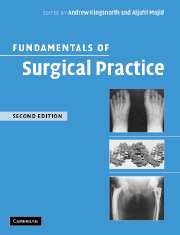Book contents
- Frontmatter
- Contents
- Preface
- Contributors
- 1 Preoperative management
- 2 Principles of anaesthesia
- 3 Postoperative management
- 4 Nutritional support
- 5 Surgical sepsis: prevention and therapy
- 6 Surgical techniques and technology
- 7 Trauma: general principles of management
- 8 Intensive care
- 9 Principles of cancer management
- 10 Ethics, legal aspects and assessment of effectiveness
- 11 Haemopoietic and lymphoreticular systems: anatomy, physiology and pathology
- 12 Upper gastrointestinal surgery
- 13 Lower gastrointestinal surgery
- 14 Hernia management
- 15 Vascular surgery
- 16 Endocrine surgery
- 17 The breast
- 18 Thoracic surgery
- 19 Genitourinary system
- 20 Head and neck
- 21 The central nervous system
- 22 Musculoskeletal system
- 23 Paediatric surgery
- Index
16 - Endocrine surgery
Published online by Cambridge University Press: 15 December 2009
- Frontmatter
- Contents
- Preface
- Contributors
- 1 Preoperative management
- 2 Principles of anaesthesia
- 3 Postoperative management
- 4 Nutritional support
- 5 Surgical sepsis: prevention and therapy
- 6 Surgical techniques and technology
- 7 Trauma: general principles of management
- 8 Intensive care
- 9 Principles of cancer management
- 10 Ethics, legal aspects and assessment of effectiveness
- 11 Haemopoietic and lymphoreticular systems: anatomy, physiology and pathology
- 12 Upper gastrointestinal surgery
- 13 Lower gastrointestinal surgery
- 14 Hernia management
- 15 Vascular surgery
- 16 Endocrine surgery
- 17 The breast
- 18 Thoracic surgery
- 19 Genitourinary system
- 20 Head and neck
- 21 The central nervous system
- 22 Musculoskeletal system
- 23 Paediatric surgery
- Index
Summary
THYROID GLAND
Embryology
The thyroid gland is formed from an ectodermal down-growth from the first and second pharyngeal pouches and descends to its final level just below the cricoid cartilage. The line of descent is known as the thyroglossal tract and, by the time of birth, this has normally involuted and disappeared. During descent, the thyroid gland comes in contact with the ultimobranchial bodies from the fourth pharyngeal pouches and cells from these are thought to form the parafollicular, calcitonin producing or ‘ C-cells’ of the thyroid. On reaching its final position, the thyroid divides into two lobes with a central bridge or isthmus. The site of origin forms the foramen caecum of the tongue.
Embryological abnormalities are:
failure of descent – this may result in a lingual thyroid, an upper midline neck swelling, or a pyramidal lobe.
cell nests in a persisting thyroglossal tract – these may result in a thyroglossal cyst.
over descent resulting in a retrosternal goitre.
agensis of one lobe – this may cause confusion on an isotope scan with a solitary nodule in one lobe and a cold area on the contralateral side.
Anatomy
The normal thyroid gland consists of two lateral lobes joined in the midline by a bridge of thyroid tissue or isthmus. The lobes extend from the level of the thyroid cartilage superiorly to the 5th or 6th tracheal rings inferiorly. The isthmus is variable in width and rests on the 2nd to 4th tracheal rings.
- Type
- Chapter
- Information
- Fundamentals of Surgical Practice , pp. 304 - 321Publisher: Cambridge University PressPrint publication year: 2006



